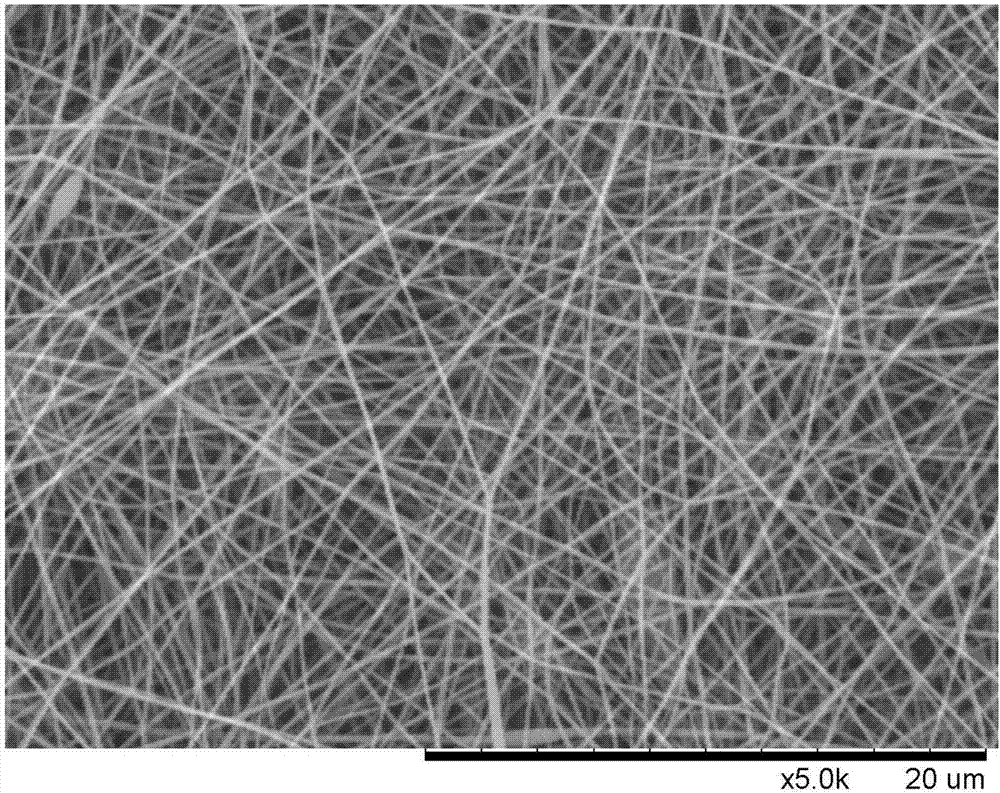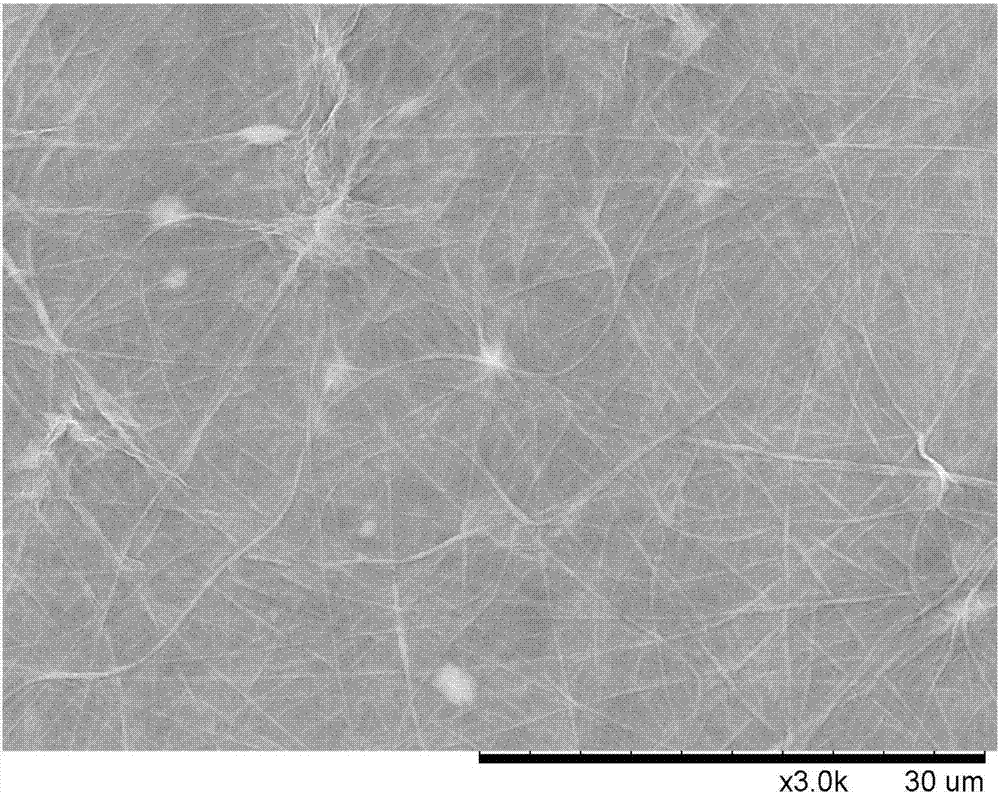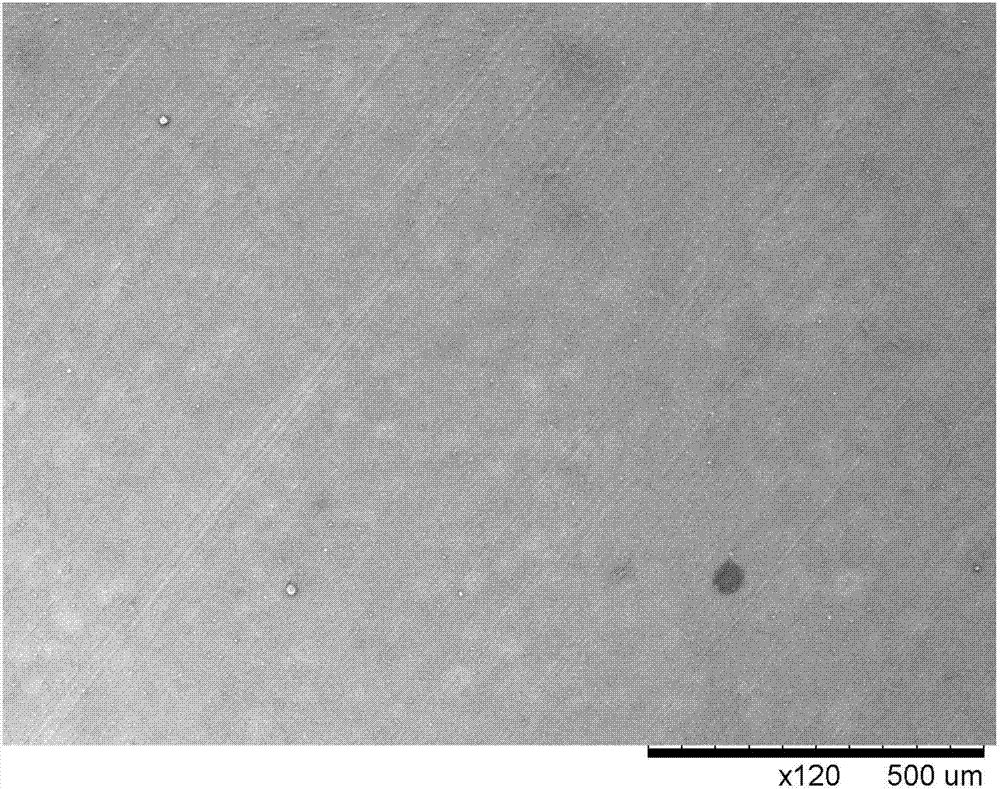Preparation method for anti-ultraviolet polyacrylonitrile nanofiber membrane
A technology of nanofiber film and polyacrylonitrile, applied in flat products, other household utensils, household utensils, etc., can solve the problem of insufficient ultraviolet shielding of conventional fabrics, achieve good anti-ultraviolet performance, good practical value and potential value, experiment The effect of mild conditions
- Summary
- Abstract
- Description
- Claims
- Application Information
AI Technical Summary
Problems solved by technology
Method used
Image
Examples
Embodiment 1
[0028] The preparation of polyacrylonitrile nanofiber membrane comprises the steps:
[0029] Step 1: Accurately weigh 0.4g of polyacrylonitrile powder, dissolve it in 5ml of DMF and magnetically stir in a constant temperature water bath at 60°C for 12h to obtain a transparent and homogeneous spinning solution of 0.08g / ml.
[0030] Step 2: Adjust the spinning parameters as positive voltage 7v, negative voltage -8v, spinning speed 0.5ml / h, and spinning distance 18cm.
[0031] Step 3: Prepare the polyacrylonitrile nanofiber membrane by electrospinning method, then let it stand for 10 minutes, and then put it into a constant temperature drying oven at 37°C to dry to obtain the polyacrylonitrile nanofiber membrane, as shown in figure 1 shown.
Embodiment 2
[0033] The preparation of graphene oxide spreading solution and the spreading of monomolecular layer on water surface comprise the steps:
[0034] Step 1: First, configure 3.0ml of a 1.0mg / ml graphene oxide aqueous solution, then add 6.0ml of methanol to the above solution, and stir for 20min to obtain a graphene oxide spreading solution with a final concentration of 0.111mg / ml.
[0035] Step 2: Take 10.0ml of the above-mentioned graphene oxide spreading solution, and carefully spread it drop by drop on the water surface in the LB tank with an area of 10*20cm, and let it stand for 20 minutes. After the methanol on the water surface is completely volatilized, move the sliding barrier , the speed is 0.5cm / min, when the distance to the sliding barrier is 1cm, stop moving, let it stand still, and wait for the self-assembly of monomolecular layer graphene oxide film to form.
Embodiment 3
[0037] The preparation of monolayer graphene oxide monomolecular layer coating polyacrylonitrile nanofiber membrane comprises the following steps:
[0038] Cut the polyacrylonitrile nanofiber membrane into a sample with a size of 5cm*2.5cm. By controlling the parameters of the film pulling machine and setting the dipping speed to 10mm / min, the polyacrylonitrile nanofiber membrane is immersed in the LB water tank and immersed in the water below the liquid surface. The length is 4cm. After waiting for the liquid level to stabilize for 20 minutes, pull the polyacrylonitrile nanofiber membrane at a pulling speed of 0.5mm / min to realize the transfer of monomolecular layer graphene oxide on the water surface to the surface of the polyacrylonitrile nanofiber membrane to obtain a single layers of graphene oxide-coated polyacrylonitrile nanofiber membranes, such as figure 2 shown.
PUM
 Login to View More
Login to View More Abstract
Description
Claims
Application Information
 Login to View More
Login to View More - R&D
- Intellectual Property
- Life Sciences
- Materials
- Tech Scout
- Unparalleled Data Quality
- Higher Quality Content
- 60% Fewer Hallucinations
Browse by: Latest US Patents, China's latest patents, Technical Efficacy Thesaurus, Application Domain, Technology Topic, Popular Technical Reports.
© 2025 PatSnap. All rights reserved.Legal|Privacy policy|Modern Slavery Act Transparency Statement|Sitemap|About US| Contact US: help@patsnap.com



